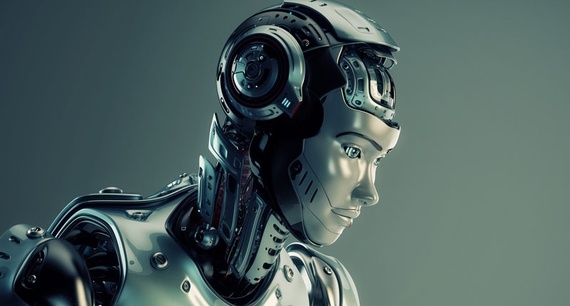
Some of today's top techies and scientists are very publicly expressing their concerns over apocalyptic scenarios that are likely to arise as a result of machines with motives. Among the fearful are intellectual heavyweights like Stephen Hawking, Elon Musk, and Bill Gates, who all believe that advances in the field of machine learning will soon yield self-aware A.I.s that seek to destroy us--or perhaps just apathetically dispose of us, much like scum getting obliterated by a windshield wiper. In fact, Dr. Hawking told the BBC, "The development of full artificial intelligence could spell the end of the human race."
Indeed, there is little doubt that future A.I. will be capable of doing significant damage. For example, it is conceivable that robots could be programmed to function as tremendously dangerous autonomous weapons unlike any seen before. Additionally, it is easy to imagine an unconstrained software application that spreads throughout the Internet, severely mucking up our most efficient and relied upon medium for global exchange.
But these scenarios are categorically different from ones in which machines decide to turn on us, defeat us, make us their slaves, or exterminate us. In this regard, we are unquestionably safe. On a sadder note, we are just as unlikely to someday have robots that decide to befriend us or show us love without being specifically prompted by instructions to do so.
This is because such intentional behavior from an A.I. would undoubtedly require a mind, as intentionality can only arise when something possesses its own beliefs, desires, and motivations. The type of A.I. that includes these features is known amongst the scientific community as "Strong Artificial Intelligence". Strong A.I., by definition, should possess the full range of human cognitive abilities. This includes self-awareness, sentience, and consciousness, as these are all features of human cognition.
On the other hand, "Weak Artificial Intelligence" refers to non-sentient A.I. The Weak A.I. Hypothesis states that our robots--which run on digital computer programs--can have no conscious states, no mind, no subjective awareness, and no agency. Such A.I. cannot experience the world qualitatively, and although they may exhibit seemingly intelligent behavior, it is forever limited by the lack of a mind.
A failure to recognize the importance of this strong/weak distinction could be contributing to Hawking and Musk's existential worries, both of whom believe that we are already well on a path toward developing Strong A.I. (a.k.a. Artificial General Intelligence). To them it is not a matter of "if", but "when".
But the fact of the matter is that all current A.I. is fundamentally Weak A.I., and this is reflected by today's computers' total absence of any intentional behavior whatsoever. Although there are some very complex and relatively convincing robots out there that appear to be alive, upon closer examination they all reveal themselves to be as motiveless as the common pocket calculator.
This is because brains and computers work very differently. Both compute, but only one understands--and there are some very compelling reasons to believe that this is not going to change. It appears that there is a more technical obstacle that stands in the way of Strong A.I. ever becoming a reality.
Turing Machines Aren't Thinking Machines
All digital computers are binary systems. This means that they store and process information exclusively in terms of two states, which are represented by different symbols--in this case 1s and 0s. It is an interesting fact of nature that binary digits can be used to represent most things; like numbers, letters, colors, shapes, images, and even audio with near perfect accuracy.
This two-symbol system is the foundational principle that all of digital computing is based upon. Everything a computer does involves manipulating two symbols in some way. As such, they can be thought of as a practical type of Turing machine--an abstract, hypothetical machine that computes by manipulating symbols.
A Turing machine's operations are said to be "syntactical", meaning they only recognize symbols and not the meaning of those symbols--i.e., their semantics. Even the word "recognize" is misleading because it implies a subjective experience, so perhaps it is better to simply say that computers are sensitive to symbols, whereas the brain is capable of semantic understanding.
It does not matter how fast the computer is, how much memory it has, or how complex and high-level the programming language. The Jeopardy and Chess playing champs Watson and Deep Blue fundamentally work the same as your microwave. Put simply, a strict symbol-processing machine can never be a symbol-understanding machine. The influential philosopher John Searle has cleverly depicted this fact by analogy in his famous and highly controversial "Chinese Room Argument", which has been convincing minds that "syntax is not sufficient for semantics" since it was published in 1980. And although some esoteric rebuttals have been put forth (the most common being the "Systems Reply"), none successfully bridge the gap between syntax and semantics. But even if one is not fully convinced based on the Chinese Room Argument alone, it does not change the fact that Turing machines are symbol manipulating machines and not thinking machines, a position taken by the great physicist Richard Feynman over a decade earlier.
Feynman described the computer as "A glorified, high-class, very fast but stupid filing system," managed by an infinitely stupid file clerk (the central processing unit) who blindly follows instructions (the software program). Here the clerk has no concept of anything--not even single letters or numbers. In a famous lecture on computer heuristics, Feynman expressed his grave doubts regarding the possibility of truly intelligent machines, stating that, "Nobody knows what we do or how to define a series of steps which correspond to something abstract like thinking."
These points present very compelling reasons to believe that we may never achieve Strong A.I., i.e., truly intelligent artificial agents. Perhaps even the most accurate of brain simulations will not yield minds, nor will software programs produce consciousness. It just might not be in the cards for a strict binary processor. There is nothing about processing symbols or computation that generates subjective experience or psychological phenomena like qualitative sensations.
Upon hearing this, one might be inclined to ask, "If a computer can't be conscious, then how can a brain?" After all, it is a purely physical object that works according to physical law. It even uses electrical activity to process information, just like a computer. Yet somehow we experience the world subjectively--from a first person perspective where inner, qualitative and ineffable sensations occur that are only accessible to us. Take for example the way it feels when you see a pretty girl, drink a beer, step on a nail, or hear a moody orchestra.
The truth is, scientists are still trying to figure all this out. How physical phenomena, like biochemical and electrical processes, create sensation and unified experience is known as the "Hard Problem of Consciousness", and is widely recognized by neuroscientists and philosophers. Even neuroscientist and popular author Sam Harris--who shares Musk's robot-rebellion concerns--acknowledges the hard problem when stating that whether a machine could be conscious is "an open question". Unfortunately he doesn't seem to fully realize that for machines to pose an existential threat arising from their own self-interests, conscious is required.
Yet although the problem of consciousness is admittedly hard, there is no reason to believe that it is not solvable by science. So what kind of progress have we made so far?
Consciousness Is A Biological Phenomenon
Much like a computer, neurons communicate with one another through exchanging electrical signals in a binary fashion. Either a neuron fires or it doesn't, and this is how neural computations are carried out. But unlike digital computers, brains contain a host of analogue cellular and molecular processes, biochemical reactions, electrostatic forces, global synchronized neuron firing at specific frequencies, and unique structural and functional connections with countless feedback loops.
Even if a computer could accurately create a digital representation of all these features, which in itself involves many serious obstacles, a simulation of a brain is still not a physical brain. There is a fundamental difference between the simulation of a physical process and the physical process itself. This may seem like a moot point to many machine learning researchers, but when considered at length it appears anything but trivial.
Simulation Does Not Equal Duplication
The Weak A.I. hypothesis says that computers can only simulate the brain, and according to some like John Searle--who coined the terms Strong and Weak A.I.--a simulation of a conscious system is very different from the real thing. In other words, the hardware of the "machine" matters, and mere digital representations of biological mechanisms have no power to cause anything to happen in the real world.
Let's consider another biological phenomenon, like photosynthesis.Photosynthesis refers to the process by which plants convert light into energy. This process requires specific biochemical reactions only viable given a material that has specific molecular and atomic properties. A perfect computer simulation--an emulation--of photosynthesis will never be able to convert light into energy no matter how accurate, and no matter what type of hardware you provide the computer with. However, there are in fact artificial photosynthesis machines. These machines do not merely simulate the physical mechanisms underlying photosynthesis in plants, but instead duplicate, the biochemical and electrochemical forces using photoelectrochemical cells that do photocatalytic water splitting.
In a similar way, a simulation of water isn't going to possess the quality of 'wetness', which is a product of a very specific molecular formation of hydrogen and oxygen atoms held together by electrochemical bonds. Liquidity emerges as a physical state that is qualitatively different from that expressed by either molecule alone.
Even the hot new consciousness theory from neuroscience, Integrated Information Theory, makes very clear that a perfectly accurate computer simulation of a brain would not have consciousness like a real brain, just as a simulation of a black hole won't cause your computer and room to implode. Neuroscientists Giulio Tononi and Christof Koch, who established the theory, do not mince words on the subject:
"IIT implies that digital computers, even if their behaviour were to be functionally equivalent to ours, and even if they were to run faithful simulations of the human brain, would experience next to nothing."
With this in mind, we can still speculate about whether non-biological machines that support consciousness can exist, but we must realize that these machines may need to duplicate the essential electrochemical processes (whatever those may be) that are occurring in the brain during conscious states. If this were possible without organic materials--which have unique molecular and atomic properties--it would presumably require more than Turing machines, which are purely syntactic processors (symbol manipulators), and digital simulations, which may lack the necessary physical mechanisms.
The best approach to achieving Strong A.I. requires finding out how the brain what it does first, and machine learning researchers' biggest mistake is to think they can take a shortcut around it. As scientists and humans, we must be optimistic about what we can accomplishment. At the same time, we must not be overly confident in ways that steer us in wrong directions and blind us from making real progress.
The Myth of Strong A.I.
Since as early as the 1960s, A.I. researchers have been claiming that Strong A.I. is just around the corner. But despite monumental increases in computer memory, speed, and processing power, we are no closer than before. So for now, just like the brainy sci-fi films of the past that depict apocalyptic A.I. scenarios, truly intelligent robots with inner conscious experience remain a fanciful fantasy.
